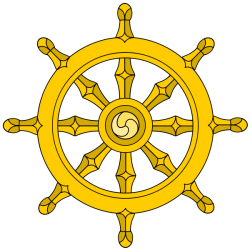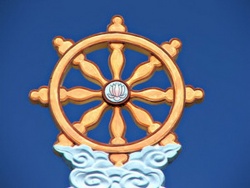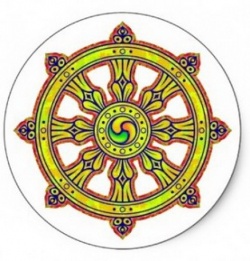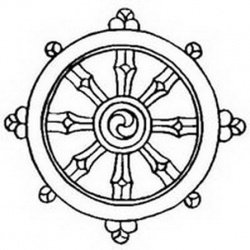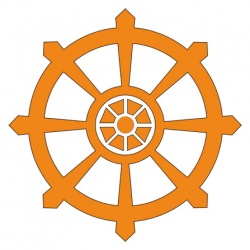Difference between revisions of "Dharmacakra"
m (Text replacement - "Central Asia" to "{{Wiki|Central Asia}}") |
|||
| Line 1: | Line 1: | ||
[[File:Dharma_Wheel.png|thumb|250px|]] | [[File:Dharma_Wheel.png|thumb|250px|]] | ||
<poem> | <poem> | ||
| − | The '''Dharmacakra''' (or [[Dharmachakra]]; Sanskrit: धर्मचक्र; Pāli: [[Dhammacakka]]; Burmese: ဓမ္မစကြာ ([dəməseʔ tɕà]); Chinese: 法輪; pinyin: fălún; Standard Tibetan: འཁོར་ལོ། (chos kyi 'khor lo); lit. "[[Wheel of Dharma]]" or "Wheel of Life") is a symbol that has represented [[dharma]], the [[Buddha]]'s teaching of the path to [[enlightenment]], since the early period of [[Indian]] [[Buddhism]]. A similar symbol is also in use in Jainism. It is one of the [[Ashtamangala]] [[symbols]]. | + | The '''[[Dharmacakra]]''' (or [[Dharmachakra]]; [[Sanskrit]]: [[धर्मचक्र]]; [[Pāli]]: [[Dhammacakka]]; [[Burmese]]: ဓမ္မစကြာ ([dəməseʔ tɕà]); {{Wiki|Chinese}}: [[法輪]]; pinyin: [[fălún]]; Standard [[Tibetan]]: {{BigTibetan|[[འཁོར་ལོ།]]}} ([[chos kyi 'khor lo]]); lit. "[[Wheel of Dharma]]" or "[[Wheel of Life"]]) is a [[symbol]] that has represented [[dharma]], the [[Buddha]]'s [[teaching]] of the [[path]] to [[enlightenment]], since the early period of [[Indian]] [[Buddhism]]. A similar [[symbol]] is also in use in [[Jainism]]. It is one of the [[Ashtamangala]] [[symbols]]. |
History | History | ||
| − | The [[Dharmachakra]] is one of the oldest known [[Buddhist]] [[symbols]] found in [[Indian]] art, appearing with the first surviving post-Harappan Indian iconography in the time of the [[Buddhist]] king [[Aśoka]]. It has been used by [[Buddhist]] nations as a [[symbol]] ever since. In its simplest form, the [[Dharmachakra]] is recognized globally as a symbol for [[Buddhism]]. | + | The [[Dharmachakra]] is one of the oldest known [[Buddhist]] [[symbols]] found in [[Indian]] [[art]], appearing with the first surviving post-Harappan [[Indian]] {{Wiki|iconography}} in the [[time]] of the [[Buddhist]] [[king]] [[Aśoka]]. It has been used by [[Buddhist]] nations as a [[symbol]] ever since. In its simplest [[form]], the [[Dharmachakra]] is [[recognized]] globally as a [[symbol]] for [[Buddhism]]. |
[[Symbolism]] | [[Symbolism]] | ||
| Line 12: | Line 12: | ||
Eight spokes representing the [[Noble Eightfold Path]] ([[Ariya magga]]). | Eight spokes representing the [[Noble Eightfold Path]] ([[Ariya magga]]). | ||
| − | 12 spokes representing the Twelve Laws of Dependent Origination ([[Paticcasamuppāda]]) or the twelve permutations of the [[four noble truths]]. | + | 12 spokes representing the Twelve Laws of [[Dependent Origination]] ([[Paticcasamuppāda]]) or the twelve permutations of the [[four noble truths]]. |
24 spokes representing the Twelve Laws of [[Dependent Origination]] and the Twelve Laws of Dependent Termination ([[Paticcasamuppāda]]). | 24 spokes representing the Twelve Laws of [[Dependent Origination]] and the Twelve Laws of Dependent Termination ([[Paticcasamuppāda]]). | ||
| − | 31 spokes representing 31 realms of existence (11 [[realms]] of [[desire]], 16 realms of form and four realms of formlessness). | + | 31 spokes representing 31 [[realms]] of [[existence]] (11 [[realms]] of [[desire]], 16 [[realms]] of [[form]] and four [[realms]] of [[formlessness]]). |
[[File:MFIwrG8.jpg|thumb|250px|]] | [[File:MFIwrG8.jpg|thumb|250px|]] | ||
In [[Buddhism]], Parts of the [[Dharmacakra]] also representing: | In [[Buddhism]], Parts of the [[Dharmacakra]] also representing: | ||
| − | Its overall shape is that of a circle ([[cakra]]), representing the perfection of the [[dharma]] teaching | + | Its overall shape is that of a circle ([[cakra]]), representing the [[perfection]] of the [[dharma]] [[teaching]] |
| − | The hub stands for discipline, which is the essential core of [[meditation]] practice | + | The hub stands for [[discipline]], which is the [[essential]] core of [[meditation]] practice |
| − | The rim, which holds the spokes, refers to mindfulness or [[samādhi]] which holds everything together | + | The rim, which holds the spokes, refers to [[mindfulness]] or [[samādhi]] which holds everything together |
Each spoke represents the [[Noble Eightfold Path]] including | Each spoke represents the [[Noble Eightfold Path]] including | ||
| − | Right beliefs | + | Right [[beliefs]] |
Right aspirations | Right aspirations | ||
| − | Right speech | + | [[Right speech]] |
| − | Right conduct | + | [[Right conduct]] |
| − | Right livelihood | + | [[Right livelihood]] |
| − | Right effort | + | [[Right effort]] |
| − | Right mindfulness | + | [[Right mindfulness]] |
| − | Right [[meditational]] attainment | + | Right [[meditational]] [[attainment]] |
| − | The corresponding [[mudrā]], or symbolic hand gesture, is known as the [[Dharmacakra Mudrā]]. | + | The corresponding [[mudrā]], or [[symbolic]] hand gesture, is known as the [[Dharmacakra Mudrā]]. |
| − | The [[Dharmachakra]] is one of the eight auspicious symbols of [[Tibetan Buddhism]]. | + | The [[Dharmachakra]] is one of the [[eight auspicious symbols]] of [[Tibetan Buddhism]]. |
[[File:Dharmachakra 287.jpg|thumb|250px|]] | [[File:Dharmachakra 287.jpg|thumb|250px|]] | ||
| − | The [[dharma wheel]] can refer to the dissemination of the [[dharma]] teaching from country to country. In this sense the [[dharma wheel]] began rolling in [[India]], carried on to {{Wiki|Central Asia}}, and then arrived in South East Asia and East Asia. | + | The [[dharma wheel]] can refer to the dissemination of the [[dharma]] [[teaching]] from country to country. In this [[sense]] the [[dharma wheel]] began rolling in [[India]], carried on to {{Wiki|Central Asia}}, and then arrived in [[South East]] {{Wiki|Asia}} and {{Wiki|East Asia}}. |
| − | Multiple turnings of the Wheel | + | Multiple turnings of the [[Wheel]] |
| − | [[Mahayana]] schools classify [[Buddhist teachings]] in turns of a sequential scheme of development. These phases are called "turnings" of the [[Dharmacakra]] (Sanskrit: [[dharmacakra-pravartana]]). | + | [[Mahayana]] schools classify [[Buddhist teachings]] in turns of a sequential scheme of development. These phases are called "turnings" of the [[Dharmacakra]] ([[Sanskrit]]: [[dharmacakra-pravartana]]). |
| − | All Buddhists agree that the original turning of the wheel occurred when the [[Buddha]] taught the five ascetics who became his first disciples at the Deer Park in [[Sarnath]]. In memory of this, the [[Dharmacakra]] is sometimes represented with a deer on each side. | + | All [[Buddhists]] agree that the original turning of the [[wheel]] occurred when the [[Buddha]] taught the [[five ascetics]] who became his first [[disciples]] at the [[Deer Park]] in [[Sarnath]]. In [[memory]] of this, the [[Dharmacakra]] is sometimes represented with a {{Wiki|deer}} on each side. |
| − | In [[Theravāda Buddhism]], this was the only "turning of the wheel", and later developments of the [[Buddhist]] [[doctrine]] which do not appear in the [[Pali Canon]] or the [[Agamas]] are not accepted as teachings of the historical [[Buddha]]. | + | In [[Theravāda Buddhism]], this was the only "turning of the [[wheel]]", and later developments of the [[Buddhist]] [[doctrine]] which do not appear in the [[Pali Canon]] or the [[Agamas]] are not accepted as teachings of the historical [[Buddha]]. |
| − | Other schools of [[Buddhism]], such as the [[Mahāyāna]] and [[Vajrayāna]] distinguish later "turnings". Specific accounts of them vary. In one, the first turning of the [[Dharmacakra]] is [[Gautama]] [[Buddha]]'s original teaching, in particular the [[Four Noble Truths]] which describes the mechanics of [[attachment]], [[desire]], [[suffering]], and [[liberation]] via the [[Eightfold Path]]; the second turning is the teaching of the [[Perfection of Wisdom sutra]], a foundational text of [[Mahayana Buddhism]]; and the third is the teaching of the [[Mahavairocana Sutra]], a foundational text of [[Tantric Buddhism]]. | + | Other schools of [[Buddhism]], such as the [[Mahāyāna]] and [[Vajrayāna]] distinguish later "turnings". Specific accounts of them vary. In one, the first turning of the [[Dharmacakra]] is [[Gautama]] [[Buddha]]'s original [[teaching]], in particular the [[Four Noble Truths]] which describes the mechanics of [[attachment]], [[desire]], [[suffering]], and [[liberation]] via the [[Eightfold Path]]; the second turning is the [[teaching]] of the [[Perfection of Wisdom sutra]], a foundational text of [[Mahayana Buddhism]]; and the third is the [[teaching]] of the [[Mahavairocana Sutra]], a foundational text of [[Tantric Buddhism]]. |
[[File:Dharmachakra-200.jpg|thumb|250px|]] | [[File:Dharmachakra-200.jpg|thumb|250px|]] | ||
| − | In another scheme, the second turning of the [[Dharmacakra]] is the [[Abhidharma]], the third is the [[Mahāyāna]] Perfection of Wisdom Sutras, and the fourth includes both the [[Yogacara]] [[sutras]] and [[Tathāgatagarbha]] [[sutras]]. | + | In another scheme, the second turning of the [[Dharmacakra]] is the [[Abhidharma]], the third is the [[Mahāyāna]] [[Perfection of Wisdom Sutras]], and the fourth includes both the [[Yogacara]] [[sutras]] and [[Tathāgatagarbha]] [[sutras]]. |
Other uses | Other uses | ||
| − | In [[Ananda Marga]], [[Shrii Shrii Anandamurtiji]], the [[Spiritual]] [[Master]] of the modern [[Tantra]] [[Yoga]] emphasizes the practice of [[Dharmacakra]] on his teachings representing a collective Kiirtan and [[Meditation]] by the [[Sadhakas]] (Spiritual Aspirants) To create and vibrate a very positive energy that enhances the Physical Sphere, [[Mental]] Sphere and [[Spiritual]] Sphere of a the Sadhakas (Spiritual Aspirants). Shrii Shrii Anandamurtiji offers the path of [[Sadhana]] to [[Sadhakas]]. He describes [[sadhana]] as "the transformation of fearful love into fearless love". This [[meditation]] ([[sadhana]]) for complete merger, for unification, starts with fearful love. He recommends to his disciples the practice of collective [[meditation]] at least once a week. These meetings called [[Dharma Chakras]] are preceded by the singing of few [[Prabhat Samgiita]] (or "Songs of the New Dawn", composed by Shrii Shrii Anandamurtiji himself) followed by Baba Nam Kevalam kiirtan, then the [[mantra]] called About this sound Samgacchadvam (help·info). At the end of the collective [[meditation]] the [[mantra]] About this sound Nityam Shuddham (help·info), then the spiritual gathering will end with the About this sound Guru Puja (help·info) mantra. | + | In [[Ananda Marga]], [[Shrii Shrii Anandamurtiji]], the [[Spiritual]] [[Master]] of the {{Wiki|modern}} [[Tantra]] [[Yoga]] emphasizes the practice of [[Dharmacakra]] on his teachings representing a collective Kiirtan and [[Meditation]] by the [[Sadhakas]] ([[Spiritual]] Aspirants) To create and vibrate a very positive [[energy]] that enhances the [[Physical]] [[Sphere]], [[Mental]] [[Sphere]] and [[Spiritual]] [[Sphere]] of a the Sadhakas ([[Spiritual]] Aspirants). Shrii Shrii Anandamurtiji offers the [[path]] of [[Sadhana]] to [[Sadhakas]]. He describes [[sadhana]] as "the [[transformation]] of {{Wiki|fearful}} [[love]] into [[fearless]] [[love]]". This [[meditation]] ([[sadhana]]) for complete merger, for unification, starts with {{Wiki|fearful}} [[love]]. He recommends to his [[disciples]] the practice of collective [[meditation]] at least once a week. These meetings called [[Dharma Chakras]] are preceded by the singing of few [[Prabhat Samgiita]] (or "Songs of the New Dawn", composed by Shrii Shrii Anandamurtiji himself) followed by [[Baba]] Nam Kevalam kiirtan, then the [[mantra]] called About this [[sound]] Samgacchadvam (help·info). At the end of the collective [[meditation]] the [[mantra]] About this [[sound]] Nityam Shuddham (help·info), then the [[spiritual]] [[gathering]] will end with the About this [[sound]] [[Guru Puja]] (help·info) [[mantra]]. |
[[File:Dharmachakra.JPG|thumb|250px|]] | [[File:Dharmachakra.JPG|thumb|250px|]] | ||
| − | In the Unicode computer standard, the [[Dharmacakra]] is called the "[[Wheel of Dharma]]" and found in the eight-spoked form. It is represented as U+2638 (☸). | + | In the Unicode computer standard, the [[Dharmacakra]] is called the "[[Wheel of Dharma]]" and found in the eight-spoked [[form]]. It is represented as U+2638 (☸). |
| − | The coat of arms of [[Mongolia]] includes a [[dharmacakra]] together with some other [[Buddhist]] attributes such as the [[lotus]], [[cintamani]], blue [[khata]] and [[Soyombo]]. | + | The coat of arms of [[Mongolia]] includes a [[dharmacakra]] together with some other [[Buddhist]] [[attributes]] such as the [[lotus]], [[cintamani]], blue [[khata]] and [[Soyombo]]. |
| − | Following the suggestion of Bhimrao Ambedkar, the Buddhist dharmachakra was used on the new Flag of India. | + | Following the suggestion of [[Bhimrao Ambedkar]], the [[Buddhist]] [[dharmachakra]] was used on the new [[Flag]] of [[India]]. |
| − | The national flag of the former Kingdom of [[Sikkim]] in the [[Himalayas]] featured a version of the [[Dharmacakra]]. | + | The national [[flag]] of the former {{Wiki|Kingdom}} of [[Sikkim]] in the [[Himalayas]] featured a version of the [[Dharmacakra]]. |
| − | [[Thai]] people also use a yellow flag with a red [[Dharmacakra]] as their [[Buddhist]] flag. | + | [[Thai]] [[people]] also use a yellow [[flag]] with a red [[Dharmacakra]] as their [[Buddhist]] [[flag]]. |
| − | The [[Dharmacakra]] is also the U.S. Armed Forces military chaplain insignia for [[Buddhist]] chaplains. | + | The [[Dharmacakra]] is also the U.S. Armed Forces {{Wiki|military}} chaplain insignia for [[Buddhist]] {{Wiki|chaplains}}. |
| − | In [[Jainism]], the [[Dharmacakra]] is worshipped as a symbol of the [[dharma]]. | + | In [[Jainism]], the [[Dharmacakra]] is worshipped as a [[symbol]] of the [[dharma]]. |
| − | Other "[[cakras]]" appear in other [[Indian]] traditions, e.g. [[Vishnu]]'s Sudarśanacakra, which is, however, a wheel-shaped weapon and not a representation of a teaching. | + | Other "[[cakras]]" appear in other [[Indian]] [[traditions]], e.g. [[Vishnu]]'s Sudarśanacakra, which is, however, a wheel-shaped weapon and not a [[representation]] of a [[teaching]]. |
[[Dharmacakra]] in [[Falun Gong]] | [[Dharmacakra]] in [[Falun Gong]] | ||
| − | [[Dharmacakra]] is translated as Falun in Chinese, and is therefore the most important thing in Falun Gong practice. In "The Great Consummation Way of Falun Dafa", Li Hongzhi explains, "The rotating Law Wheel has the same nature as the universe and as its miniature. The Buddhist Law Wheel, the Daoist yin-yang, and everything in the Ten-Directional World are reflected in the Law Wheel. The Law Wheel provides salvation to the cultivator when it rotates inward (clockwise), since it absorbs a great amount of energy from the universe and transforms it. The Law Wheel provides salvation to others when rotating outward (counter-clockwise), for it releases energy that can save any being and rectify any abnormal condition; people near the cultivator benefit." | + | [[Dharmacakra]] is translated as Falun in {{Wiki|Chinese}}, and is therefore the most important thing in [[Falun Gong]] practice. In "The Great Consummation Way of Falun Dafa", Li Hongzhi explains, "The rotating Law [[Wheel]] has the same [[nature]] as the [[universe]] and as its miniature. The [[Buddhist Law]] [[Wheel]], the {{Wiki|Daoist}} [[yin-yang]], and everything in the Ten-Directional [[World]] are reflected in the Law [[Wheel]]. The Law [[Wheel]] provides {{Wiki|salvation}} to the cultivator when it rotates inward ({{Wiki|clockwise}}), since it absorbs a great amount of [[energy]] from the [[universe]] and transforms it. The Law [[Wheel]] provides {{Wiki|salvation}} to others when rotating outward (counter-clockwise), for it releases [[energy]] that can save any being and rectify any abnormal [[condition]]; [[people]] near the cultivator [[benefit]]." |
</poem> | </poem> | ||
{{W}} | {{W}} | ||
[[Category:Dharmacakra]] | [[Category:Dharmacakra]] | ||
Revision as of 10:17, 8 November 2013
The Dharmacakra (or Dharmachakra; Sanskrit: धर्मचक्र; Pāli: Dhammacakka; Burmese: ဓမ္မစကြာ ([dəməseʔ tɕà]); Chinese: 法輪; pinyin: fălún; Standard Tibetan: འཁོར་ལོ། (chos kyi 'khor lo); lit. "Wheel of Dharma" or "Wheel of Life") is a symbol that has represented dharma, the Buddha's teaching of the path to enlightenment, since the early period of Indian Buddhism. A similar symbol is also in use in Jainism. It is one of the Ashtamangala symbols.
History
The Dharmachakra is one of the oldest known Buddhist symbols found in Indian art, appearing with the first surviving post-Harappan Indian iconography in the time of the Buddhist king Aśoka. It has been used by Buddhist nations as a symbol ever since. In its simplest form, the Dharmachakra is recognized globally as a symbol for Buddhism.
Symbolism
In Buddhism—according to the Pali Canon, Vinayapitaka, Khandhaka, Mahavagga, and Dhammacakkappavattanasutta—the number of spokes of the Dharmacakra represent various meanings:
Eight spokes representing the Noble Eightfold Path (Ariya magga).
12 spokes representing the Twelve Laws of Dependent Origination (Paticcasamuppāda) or the twelve permutations of the four noble truths.
24 spokes representing the Twelve Laws of Dependent Origination and the Twelve Laws of Dependent Termination (Paticcasamuppāda).
31 spokes representing 31 realms of existence (11 realms of desire, 16 realms of form and four realms of formlessness).
In Buddhism, Parts of the Dharmacakra also representing:
Its overall shape is that of a circle (cakra), representing the perfection of the dharma teaching
The hub stands for discipline, which is the essential core of meditation practice
The rim, which holds the spokes, refers to mindfulness or samādhi which holds everything together
Each spoke represents the Noble Eightfold Path including
Right beliefs
Right aspirations
Right speech
Right conduct
Right livelihood
Right effort
Right mindfulness
Right meditational attainment
The corresponding mudrā, or symbolic hand gesture, is known as the Dharmacakra Mudrā.
The Dharmachakra is one of the eight auspicious symbols of Tibetan Buddhism.
The dharma wheel can refer to the dissemination of the dharma teaching from country to country. In this sense the dharma wheel began rolling in India, carried on to Central Asia, and then arrived in South East Asia and East Asia.
Multiple turnings of the Wheel
Mahayana schools classify Buddhist teachings in turns of a sequential scheme of development. These phases are called "turnings" of the Dharmacakra (Sanskrit: dharmacakra-pravartana).
All Buddhists agree that the original turning of the wheel occurred when the Buddha taught the five ascetics who became his first disciples at the Deer Park in Sarnath. In memory of this, the Dharmacakra is sometimes represented with a deer on each side.
In Theravāda Buddhism, this was the only "turning of the wheel", and later developments of the Buddhist doctrine which do not appear in the Pali Canon or the Agamas are not accepted as teachings of the historical Buddha.
Other schools of Buddhism, such as the Mahāyāna and Vajrayāna distinguish later "turnings". Specific accounts of them vary. In one, the first turning of the Dharmacakra is Gautama Buddha's original teaching, in particular the Four Noble Truths which describes the mechanics of attachment, desire, suffering, and liberation via the Eightfold Path; the second turning is the teaching of the Perfection of Wisdom sutra, a foundational text of Mahayana Buddhism; and the third is the teaching of the Mahavairocana Sutra, a foundational text of Tantric Buddhism.
In another scheme, the second turning of the Dharmacakra is the Abhidharma, the third is the Mahāyāna Perfection of Wisdom Sutras, and the fourth includes both the Yogacara sutras and Tathāgatagarbha sutras.
Other uses
In Ananda Marga, Shrii Shrii Anandamurtiji, the Spiritual Master of the modern Tantra Yoga emphasizes the practice of Dharmacakra on his teachings representing a collective Kiirtan and Meditation by the Sadhakas (Spiritual Aspirants) To create and vibrate a very positive energy that enhances the Physical Sphere, Mental Sphere and Spiritual Sphere of a the Sadhakas (Spiritual Aspirants). Shrii Shrii Anandamurtiji offers the path of Sadhana to Sadhakas. He describes sadhana as "the transformation of fearful love into fearless love". This meditation (sadhana) for complete merger, for unification, starts with fearful love. He recommends to his disciples the practice of collective meditation at least once a week. These meetings called Dharma Chakras are preceded by the singing of few Prabhat Samgiita (or "Songs of the New Dawn", composed by Shrii Shrii Anandamurtiji himself) followed by Baba Nam Kevalam kiirtan, then the mantra called About this sound Samgacchadvam (help·info). At the end of the collective meditation the mantra About this sound Nityam Shuddham (help·info), then the spiritual gathering will end with the About this sound Guru Puja (help·info) mantra.
In the Unicode computer standard, the Dharmacakra is called the "Wheel of Dharma" and found in the eight-spoked form. It is represented as U+2638 (☸).
The coat of arms of Mongolia includes a dharmacakra together with some other Buddhist attributes such as the lotus, cintamani, blue khata and Soyombo.
Following the suggestion of Bhimrao Ambedkar, the Buddhist dharmachakra was used on the new Flag of India.
The national flag of the former Kingdom of Sikkim in the Himalayas featured a version of the Dharmacakra.
Thai people also use a yellow flag with a red Dharmacakra as their Buddhist flag.
The Dharmacakra is also the U.S. Armed Forces military chaplain insignia for Buddhist chaplains.
In Jainism, the Dharmacakra is worshipped as a symbol of the dharma.
Other "cakras" appear in other Indian traditions, e.g. Vishnu's Sudarśanacakra, which is, however, a wheel-shaped weapon and not a representation of a teaching.
Dharmacakra in Falun Gong
Dharmacakra is translated as Falun in Chinese, and is therefore the most important thing in Falun Gong practice. In "The Great Consummation Way of Falun Dafa", Li Hongzhi explains, "The rotating Law Wheel has the same nature as the universe and as its miniature. The Buddhist Law Wheel, the Daoist yin-yang, and everything in the Ten-Directional World are reflected in the Law Wheel. The Law Wheel provides salvation to the cultivator when it rotates inward (clockwise), since it absorbs a great amount of energy from the universe and transforms it. The Law Wheel provides salvation to others when rotating outward (counter-clockwise), for it releases energy that can save any being and rectify any abnormal condition; people near the cultivator benefit."
